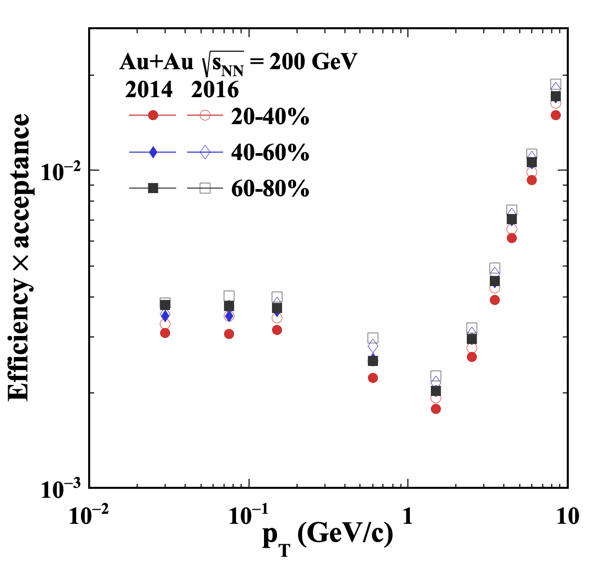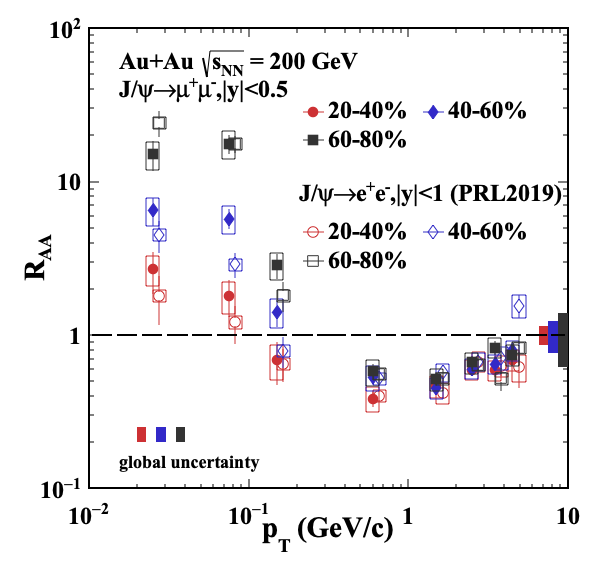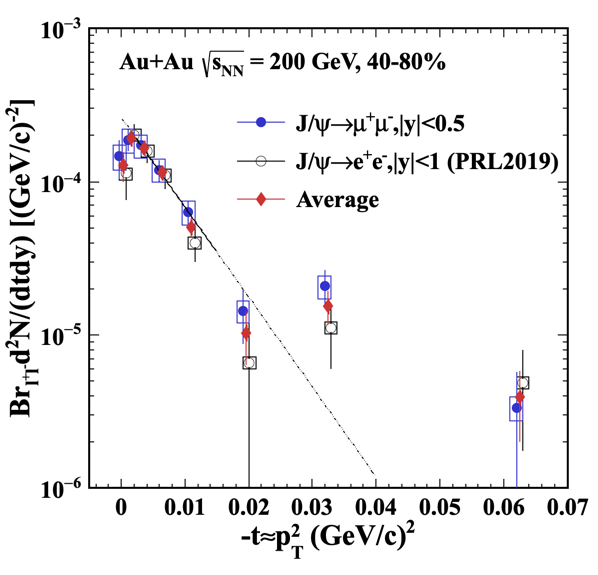Very low pT J/ψ production in Au+Au collisions at 200 GeV through the dimuon channel at STAR
Updated on Mon, 2024-05-06 00:42. Originally created by zli1 on 2023-08-14 13:59.
Very low pT J/ψ production in Au+Au collisions at √sNN =200 GeV through the dimuon channel at STAR
PAs : Ziyang Li, Zhen Liu, Rongrong Ma, Kaifeng Shen, Zebo Tang, Wangmei Zha
Target Journal: Chinese Physics C
Abstract:
Enhancements of J/ψ production at very low transverse momentum (pT < 0.2 GeV/c) above the expected hadronic interaction yields have been observed in peripheral A+A collisions by the STAR Collaboration through the dielectron channel. This phenomenon is a signature of coherent photon-nucleus interactions. In this paper, the measurements of very low pT J/ψ production in peripheral Au+Au collisions at √sNN = 200 GeV through the dimuon channel are presented. Significant J/ψ enhancements are observed at very low pT and are consistent with previous dielectron decay channel results within uncertainties. The excess yields of two decay channels are averaged and compared to equivalent photon approximation (EPA) calculation. The averaged excess yield is reasonably well described by the EPA calculation.
Figures:
|
|
| Figure 1. Unlike-sign muon pair distributions in 0 < pT < 0.15 GeV/c in different centralities. The black solid squares are unlike sign from same event. The blue lines indicate the mixed-event distributions for combinatorial background. The red curves indicate the combined fits of signal, combinatorial background and residual background using the Maximum Likelihood (ML) method. |
|
|
| Figure 2. Efficiency and detector acceptance as a function of J/ψ pT for different centralities from 2014 and 2016 datasets. |
|
|
| Figure 3. Invariant yields of J/ψ as a function of pT for different centralities within |y|<0.5. The error bars depict the statistical uncertainties while the boxes represent the systematic uncertainties. The solid lines are the fits to the new results within the range of pT > 0.2 GeV/c, while the dashed lines represent the fits extrapolated down to very low pT. The bands show fit uncertainties. |
|
|
| Figure 4. The J/ψ RAA as a function of pT in 200 GeV Au+Au collisions compared to similar measurements via the dielectron decay channel. Data points have been horizontally shifted for clarity.The error bars depict the statistical uncertainties, while the boxes represent the systematic uncertainties. The shaded bands at unity show the global uncertainties, which include the 10% uncertainty on p+p reference and the Ncoll uncertainties. |
|
|
| Figure 5. The coherent J/ψ excess yield as a function of the negative momentum transfer squared -t (~pT2) for the 40-80% centrality class in Au+Au collisions, in comparison with previous dielectron measurements. Data points are displaced horizontally for clarify. The error bars depict the statistical uncertainties, while the boxes represent the systematic uncertainties. The black solid line is an exponential fit to the average resutls. The dashed black line is an extrapolation of the fit. |
|
|
| Figure 6. The pT-integrated excess J/ψ yield (pT < 0.1 GeV/c) with the expected hadronic contribution subtracted as a function of Npart in comparison with previous dielectron channel measurement and a model calculation. Data points have been horizontally shifted for clarity. The error bars depict the statistical uncertainties, while the boxes represent the systematic uncertainties. |
Summary:
In summary, we present the measurements of coherent photo-induced J/ψ production in 30-80% Au+Au collisions at √sNN = 200 GeV with the STAR detector at RHIC.
- This is for the first time that STAR has measured very low pT J/ψ production via the dimuon channel.
- The pT distributions reveal significant enhancement within pT < 0.2 GeV/c with respect to the expected hadronic contribution.
- The nuclear modification factor RAA is also calulated, an enhancement above unity in 60-80% centrality class is observed, with values reaching 15±3 (stat.)±3 (syst.) and 17±4±4 for 0 < pT < 0.05 and 0.05 < pT < 0.1 GeV/c.
- The coherent J/ψ yield as a function of -t (~ pT2) in 40-80% peripheral Au+Au collisions is presented. The extracted slope parameters from this analysis, from previously published dielectron results, as well as from combined results seem to be systematically lower than that anticipated for an Au nucleus theoretically. Maybe a hint that the interaction may not involve the entire target nucleus in peripheral collisions.
- Comparison of the measurements to EPA calculation shows that the excess yield can be described reasonably well, which further supports the conclusion that the observed J/ψ yield enhancement beyond hadronic contribution at very low pT originate from photon-induced interactions.
Related presentations:
Here is a summary of links about related presentations on pwg meeting.
- https://drupal.star.bnl.gov/STAR/system/files/STARmeeting_ziyang.pdf
- https://drupal.star.bnl.gov/STAR/blog/zli1/Run14-very-low-pT-Jpsi-preliminary-request
- https://drupal.star.bnl.gov/STAR/system/files/STARmeeting_20220912_lzy_v3_0.pdf
- https://drupal.star.bnl.gov/STAR/system/files/JpsiRun14_lzy_v4.pdf
- https://drupal.star.bnl.gov/STAR/system/files/JpsiRun14_lzy_0.pdf
»
- zli1's blog
- Login or register to post comments

.png)
.png)

.png)


.png)